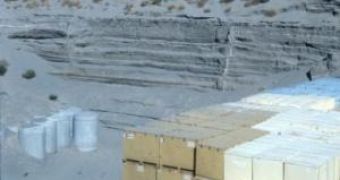Nuclear waste is remnant radioactive material resulted from the nuclear weapons program, or from processing in the nuclear power plants, which cannot be further used for other industrial activities. It is usually extremely radioactive, and has half life time in the range of millions of years, thus a solution must be found for the further conversion of these materials as they pose great security threats related to polluting the areas around the storage facilities with radioactive materials.
Usually the so-called storage facilities, present no special containing conditions, and are just left by the millions of barrels in the middle of nowhere. This is also the case of a hazardous nuclear waste storage facility which deposits resulting waste from the U.S. nuclear weapons program, situated in the southeast of the Washington state, in a place called Hanford. Under the sand of the desert landscape, about a hundred tons of radioactive material lies in the stratified vadose zone. The complex is close to the Columbia river, thus the migration of these containers; the composition is of great importance to the people living in the area.
The studies regarding the soil in which these containers are stored reveal that the fine sediment layers, influenced by rain, snow or different clime conditions, can affect the conditions of the contaminants' transport. The behavior of liquid phases seeping through the different layers of the soil, has been studied with great detail by understanding what happens to water when it infiltrates the ground, to know how a contaminant might behave like in different conditions.
By understanding how these chemicals react in the vadose zone, the factors which control the interactions are the answer to the problem related to the future storage of nuclear waste, in the area around the Hanford complex.
The chemical analysis of the soil at the Hanford site reveals that the sediment present in that particular area reacts to a number of chemical elements such as cesium. Other contaminants have also been found, such as uranium, tritium and nitrate, which are being transported deep under the vadose to reach the groundwater.
The investigating team present in the Hanford area, is focusing on the study of the path these contaminants take inside the vadose, to evaluate the extent of the damage, and how the problem can be remedied depending on the speeds at which the contaminants continue their movement.

 14 DAY TRIAL //
14 DAY TRIAL //